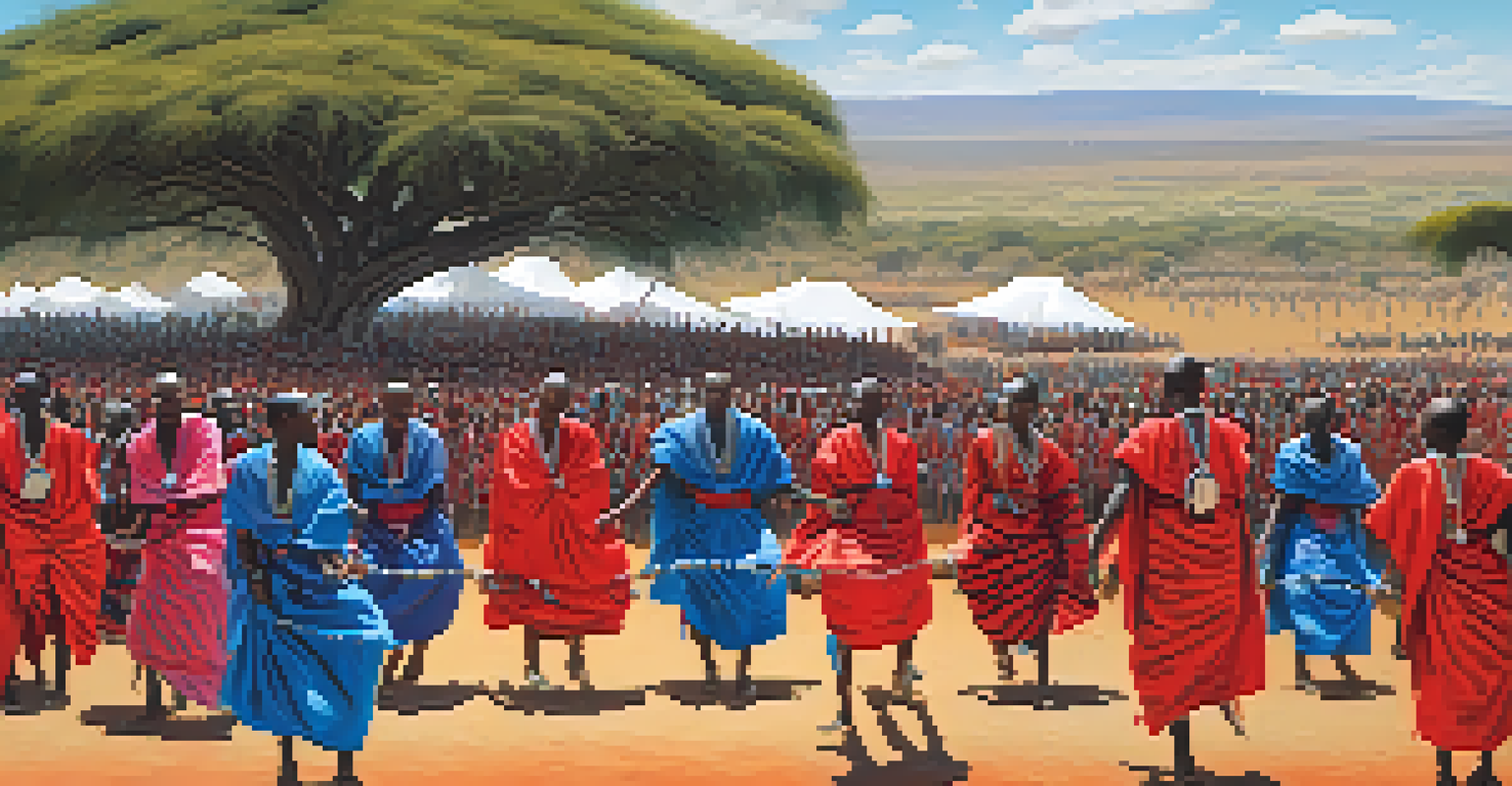Cultural Dances Reflecting Environmental Sustainability

Understanding Cultural Dances and Their Significance
Cultural dances are more than just artistic expressions; they are a reflection of a community's values and beliefs. Each dance tells a story, often rooted in history, spirituality, or social practices. For many cultures, these dances serve as a means to connect with the earth and its resources, highlighting the intricate relationship between humans and nature.
Dance is the hidden language of the soul.
Take, for example, the traditional dances of Indigenous peoples. These performances often embody respect for the land, showcasing rituals that celebrate the changing seasons, harvests, and wildlife. By participating in these dances, communities reinforce their commitment to stewardship of the environment, passing down important lessons to future generations.
Moreover, cultural dances can be a powerful tool for education. They engage audiences in a narrative that emphasizes harmony with nature, encouraging a collective responsibility toward sustainability. This connection can inspire individuals to adopt environmentally friendly practices in their own lives.
The Role of Dance in Environmental Awareness
Dance has an unparalleled ability to convey messages and evoke emotions. When cultural dances incorporate themes of environmental sustainability, they can effectively raise awareness about ecological issues. For instance, some contemporary dance troupes are increasingly integrating environmental themes into their performances, using movement as a medium for advocacy.

These performances not only entertain but also educate audiences on pressing issues like climate change and habitat destruction. Just as a painter uses colors to express feelings, dancers use their bodies to illustrate the consequences of neglecting our planet. By experiencing these dances, viewers can develop a deeper understanding of the urgency of protecting our environment.
Cultural Dances Reflect Community Values
Cultural dances express a community's beliefs and connection to the environment, often passing down important lessons to future generations.
Furthermore, festivals celebrating cultural dances often include workshops and discussions on sustainability practices. This blend of art and education creates a vibrant atmosphere where participants can learn and engage, fostering a community-wide commitment to environmental action.
Examples of Dances Promoting Sustainability
Around the globe, various cultural dances have emerged as champions of environmental sustainability. For instance, the Hula dance from Hawaii emphasizes the importance of nature and the interconnectedness of all living beings. Through its movements and chants, Hula invites practitioners and observers to appreciate the beauty of the land and the ocean, reinforcing the need to protect these natural resources.
Art is not a mirror held up to reality, but a hammer with which to shape it.
In Africa, the Adumu dance of the Maasai people celebrates the resilience of their herding lifestyle while highlighting the importance of biodiversity. This lively dance is not just a performance but a reminder of the delicate balance between human activities and the environment. It encourages sustainable practices that ensure the survival of both the Maasai culture and the ecosystems they depend on.
Similarly, the traditional dances of the Ainu people in Japan often depict the beauty of nature and the importance of coexistence with wildlife. These dances serve as a medium to express gratitude for the gifts of the earth, inspiring communities to honor their environmental commitments.
Dance Festivals: A Platform for Environmental Dialogue
Dance festivals around the world often serve as a platform for promoting environmental sustainability. These events bring together performers and audiences from diverse backgrounds, creating a unique space for discussion and learning. By incorporating themes of sustainability into their programming, festivals can amplify the message of conservation and responsible living.
At these festivals, attendees not only enjoy the performances but also engage in workshops and discussions about environmental issues. This interaction fosters a sense of community and shared responsibility toward the planet. Participants leave with a renewed commitment to sustainability, inspired by the performances they've witnessed.
Dance as a Tool for Environmental Advocacy
Cultural dances can effectively raise awareness about ecological issues, encouraging audiences to adopt sustainable practices through engaging performances.
Moreover, many festivals partner with local environmental organizations to create initiatives that support conservation efforts. This collaboration enhances the impact of cultural dances, transforming entertainment into actionable steps toward a healthier planet.
The Influence of Globalization on Cultural Dances
Globalization has significantly impacted cultural dances, both positively and negatively. While it has facilitated the sharing of diverse dance forms across borders, it has also led to the commodification of some traditions. As cultures merge, there is a risk that the original messages about sustainability might become diluted or lost.
However, many artists are using globalization to their advantage by incorporating environmental themes into their modern interpretations of traditional dances. This fusion not only preserves the essence of the original dances but also makes them relevant to contemporary audiences. By addressing current environmental issues, these adaptations maintain the cultural significance while promoting sustainability.
Ultimately, the challenge lies in balancing tradition with modernity. By honoring the roots of cultural dances while adapting them to reflect today's environmental challenges, artists can create a powerful narrative that resonates with people around the world.
How Cultural Dances Inspire Action for Sustainability
Cultural dances serve as a catalyst for inspiring individuals to take action for sustainability. When people engage with these performances, they often feel a sense of connection to the issues being portrayed. This emotional engagement can be a powerful motivator for change, encouraging individuals to adopt more eco-friendly practices in their daily lives.
For instance, after witnessing a dance that highlights the plight of endangered species, audience members may feel compelled to support wildlife conservation efforts. This direct correlation between art and action illustrates how cultural dances can transcend entertainment and become a vehicle for social change.
Globalization Shapes Dance Traditions
While globalization can dilute traditional messages, many artists are adapting cultural dances to address contemporary environmental challenges.
Moreover, the communal aspect of dance fosters a sense of solidarity. When people come together to celebrate their culture and discuss sustainability, they create a supportive environment that encourages collective action. This unity can lead to impactful community initiatives aimed at protecting the environment.
The Future of Cultural Dances and Sustainability
As we look to the future, the intersection of cultural dances and environmental sustainability will likely continue to evolve. With growing awareness of climate change and ecological issues, more artists may feel inspired to incorporate these themes into their work. This shift could lead to a resurgence of traditional dances that celebrate nature and promote sustainable practices.
Furthermore, technology and social media can play a significant role in amplifying the messages of cultural dances. Artists can reach wider audiences, sharing their performances online and sparking conversations about environmental responsibility. This global reach can inspire individuals from different backgrounds to join the movement toward sustainability.

Ultimately, the future of cultural dances lies in their ability to adapt and respond to the challenges we face as a society. By embracing innovation while remaining true to their roots, these art forms can continue to inspire generations to honor and protect our planet.